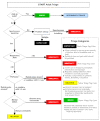Emergency department triage: an ethical analysis
- PMID: 21982119
- PMCID: PMC3199257
- DOI: 10.1186/1471-227X-11-16
Emergency department triage: an ethical analysis
Abstract
Background: Emergency departments across the globe follow a triage system in order to cope with overcrowding. The intention behind triage is to improve the emergency care and to prioritize cases in terms of clinical urgency.
Discussion: In emergency department triage, medical care might lead to adverse consequences like delay in providing care, compromise in privacy and confidentiality, poor physician-patient communication, failing to provide the necessary care altogether, or even having to decide whose life to save when not everyone can be saved. These consequences challenge the ethical quality of emergency care. This article provides an ethical analysis of "routine" emergency department triage. The four principles of biomedical ethics - viz. respect for autonomy, beneficence, nonmaleficence and justice provide the starting point and help us to identify the ethical challenges of emergency department triage. However, they do not offer a comprehensive ethical view. To address the ethical issues of emergency department triage from a more comprehensive ethical view, the care ethics perspective offers additional insights.
Summary: We integrate the results from the analysis using four principles of biomedical ethics into care ethics perspective on triage and propose an integrated clinically and ethically based framework of emergency department triage planning, as seen from a comprehensive ethics perspective that incorporates both the principles-based and care-oriented approach.
Figures
References
-
- Australasian College for Emergency Medicine. Policy document -- standard terminology. Emerg Med (Fremantle) 2002;14:337–340. - PubMed
-
- Carrus B, Corbett S, Kandelwai D. A hospital-wide strategy for fixing ED overcrowding. Health International. 2009;9:6–17.
MeSH terms
LinkOut - more resources
Full Text Sources




